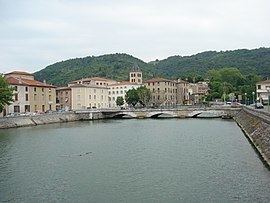Time zone CET (UTC+1) Population 4,154 (1999) | Canton Saint-Vallier Area 5.42 km² Local time Wednesday 3:22 AM | |
 | ||
Intercommunality Les Deux Rives de la Région de Saint-Vallier Weather 9°C, Wind NW at 6 km/h, 72% Humidity | ||
Saint-Vallier is a commune in the Drôme department in southeastern France. It is an administrative, commercial and industrial town at the confluence of the rivers Galaure and Rhone.
Contents
- Map of 26240 Saint Vallier France
- Geography
- Ancient Rome
- Middle Ages
- Modern
- Fossil site
- Personalities
- Castles
- Downtown
- References
Map of 26240 Saint-Vallier, France
Geography
The town is situated on the bank of the River Rhone, 30 kilometres (19 mi) north of Valence. The River Galaure flows northwest through the southern part of the commune, crosses the town, then flows into the Rhone, which forms the commune's western border.
The town covers an area of 464 hectares and has just over four thousand inhabitants.
It is the county town of the canton and is important as an administrative, industrial and commercial centre. It has developed in a linear fashion along the bank of the Rhone and has a catchment area of about fifteen thousand inhabitants. It has a number of factories and industrial units making aviation parts, ceramic insulators, nuclear taps, tiles and stationery.
Ancient Rome
The Roman town of Ursuli was built on this site at the confluence of the Galaure and the Rhone.
Middle Ages
The Château de Diane de Poitiers was built in the fifteenth century. It is flanked by corner towers that dominate the Galaure River. The château is surrounded by a landscaped garden designed by Le Nôtre. Château des Rioux is another ancient castle beside the three hectare Parc à l'Anglaise. It originally housed a religious community of monks but was rebuilt in the nineteenth century by Comte Dupeyroux de Salmagne. It offers accommodation in a gite and four guest chambers. The old city walls are still visible on the Place Orsolles and there is a covered market, built in 1852.
Modern
In the eighteenth century, feldspar and kaolin were found in the area and an industry grew up making hard-paste porcelain fired at a high temperature.
On August 16, 1944, 28 American B17 tried to destroy the railroad bridge, causing many deaths and damages to the south of the town.
If you want to learn more about the history and the "Montrebut" paleontological site of Saint-Vallier, there is a dedicated room near the local council building.
Fossil site
Near Saint-Vallier, on the "Montrebut" hill, there is a fossil bed that serves as a biostratigraphical reference locality. Flowing water has buried the remains of animals over many millennia and careful excavations can help paleontologists understand the relative ages of different rock strata according to the different fossil remains found. This is one of only two locations in which fossils of the extinct badger species Meles thorali have been found.
Personalities
Saint-Vallier is the birthplace of Diane de Poitiers, one of the most well-known of French royal mistresses, born in 1499. She became the favourite of Henry II of France and wielded much power until he was fatally wounded in 1559 in a jousting tournament and his widow, Catherine de' Medici, expelled her from the court.
